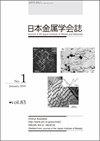Ni基単結晶超合金TMS-238のデンドライト偏析とクリープ強度におよぼす溶体化熱処理の影響
IF 0.4
4区 材料科学
Q4 METALLURGY & METALLURGICAL ENGINEERING
引用次数: 1
Abstract
To reduce the cost of solution heat treatment process Ni-base single crystal superalloy TMS-238 containing Re and Ru, quantitative analysis of dendrite-interdendrite segregation of alloying elements under various solution heat treatment conditions were conducted, and influence on high-temperature creep strength were investigated. In this study, we defined the solution rate Rsol (= (1 − Vf,e) × 100%, where Vf,e is volume fraction of eutectic γ′ that precipitates in the final solidification zone during casting) as a parameter to reveal the microstructure homogeneity. The Rsol values were 71%, 97%, 99%, 100% for solutioning at 1250℃/20 h, 1320℃/5 h, 1320℃/20 h and 1335℃/20 h, respectively. Furthermore, it was confirmed that Re and W segregated in the dendrite core area and γ′ formers whereas Ta and Al segregated in the interdendrite. The magnitude of these segregations decreased as the solution temperature and time increased, and eventually the structure became almost homogeneous for solutioning at 1335℃ for 20 h. Additionally, creep test results indicate that Larson-Miller parameter (LMP) at 800℃-735 MPa, 900℃-392 MPa and 1000℃-245 MPa creep conditions show the same values for Rsol ≥ 97%. On the other hand, under 1100℃-137 MPa creep condition, LMP decreased as the Rsol decreased. A factor analysis of creep rupture properties suggested that the degradation of LMP under 1100℃-137 MPa was caused by the decrease of Re content and γ/γ′ lattice misfit in the interdendritic region.Ni基单晶超合金TMS-238的铁皮偏析和溶体化热处理对蠕变强度的影响
为降低含Re、Ru镍基单晶高温合金TMS-238固溶热处理工艺成本,定量分析了不同固溶热处理条件下合金元素枝晶-枝晶间偏析现象,并研究了其对高温蠕变强度的影响。在本研究中,我们定义了溶解速率Rsol(=(1−Vf,e) × 100%,其中Vf,e为铸造过程中最终凝固区析出的共晶γ′的体积分数)作为反映组织均匀性的参数。在1250℃/20 h、1320℃/5 h、1320℃/20 h、1335℃/20 h条件下,Rsol值分别为71%、97%、99%、100%。Re和W在枝晶核心区和γ′区偏析,Ta和Al在枝晶间偏析。随着溶解温度和时间的增加,这些离析的幅度减小,在1335℃下溶解20 h,最终结构趋于均匀。此外,蠕变试验结果表明,在800℃-735 MPa、900℃-392 MPa和1000℃-245 MPa蠕变条件下,Rsol≥97%时,Larson-Miller参数(LMP)值相同。另一方面,在1100℃-137 MPa蠕变条件下,LMP随Rsol的减小而减小。在1100℃-137 MPa条件下,LMP的蠕变断裂性能的因素分析表明,Re含量的降低和枝晶间γ/γ′晶格失配是导致LMP的退化的主要原因。
本文章由计算机程序翻译,如有差异,请以英文原文为准。
求助全文
约1分钟内获得全文
求助全文
来源期刊

Journal of The Japan Institute of Metals
工程技术-冶金工程
CiteScore
0.70
自引率
0.00%
发文量
27
审稿时长
6-12 weeks
期刊介绍:
Information not localized
 求助内容:
求助内容: 应助结果提醒方式:
应助结果提醒方式:


